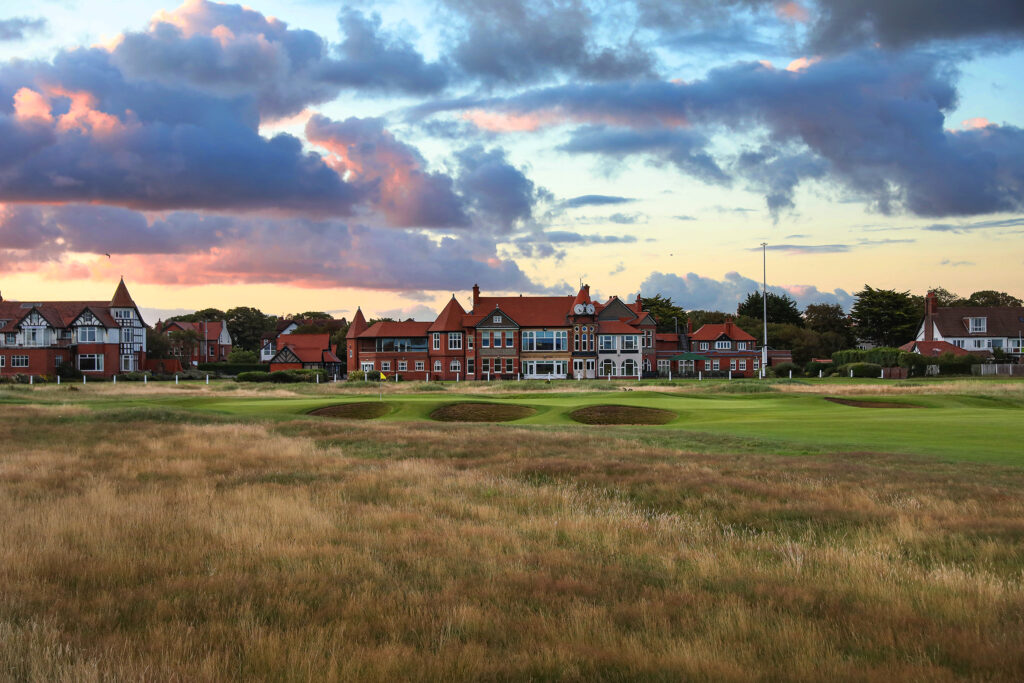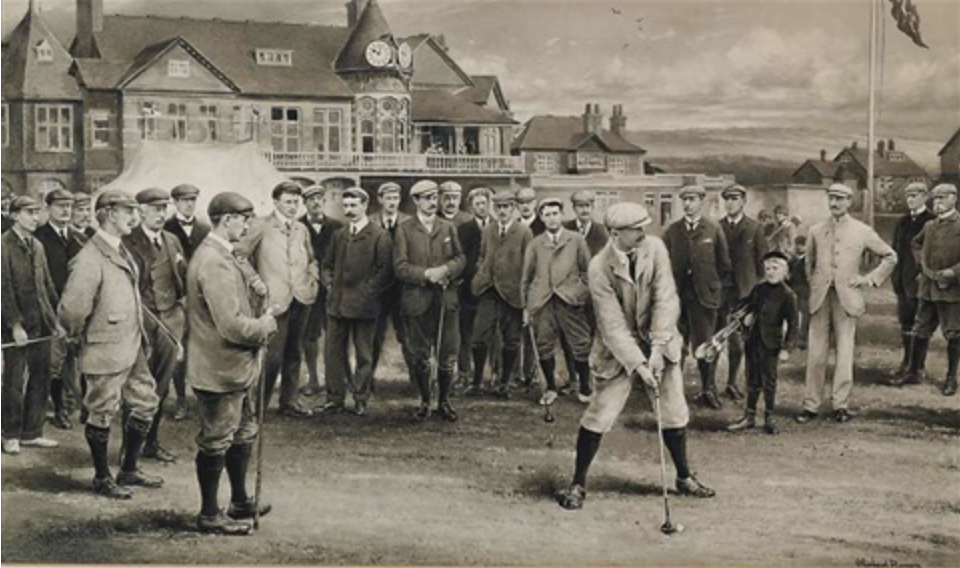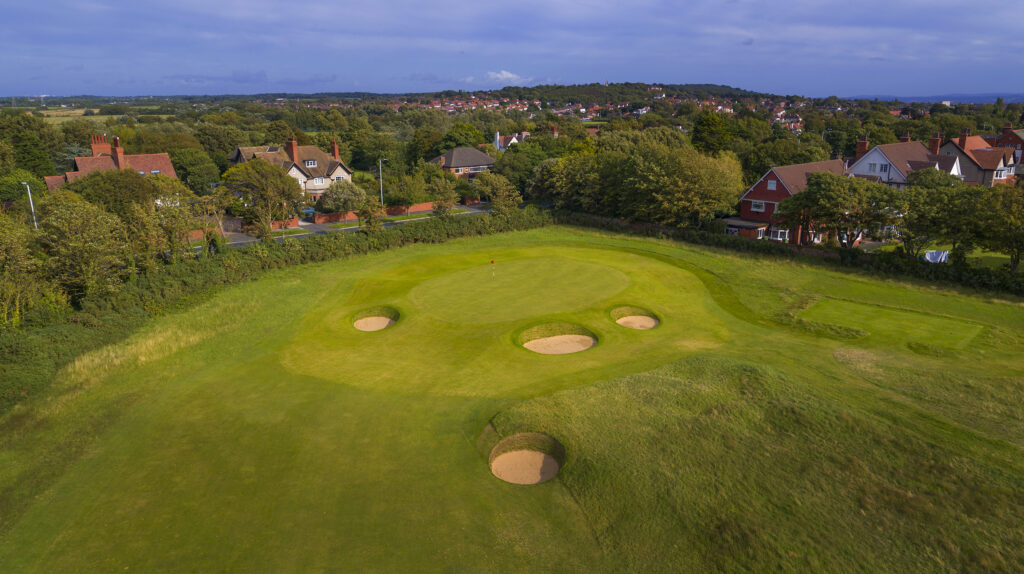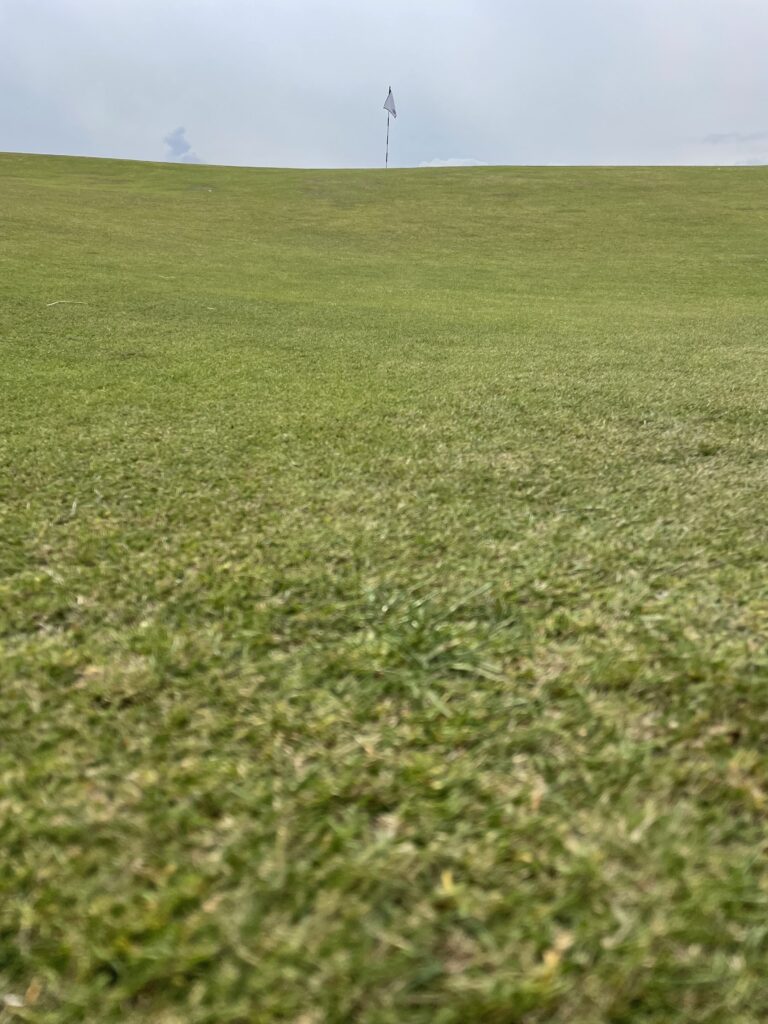
Steeped in golfing history, Royal Liverpool Golf Club is a legendary links course instrumental to the development of our beloved game. In 2023 The Open Championship returns to Hoylake for the 13th time and there’s been some significant changes made since Rory Mcilroy last won the claret jug here in 2014. I’ve been lucky enough to play Royal Liverpool quite a few times over the years so I was very excited to see the architectural changes made to the course in recent years by Martin Ebert. Read on to hear my verdict on what to expect of the course for the 151st Open Championship in 2023 and why Hoylake is such a significant place for the game of golf.
History of royal liverpool golf club
The first golf at Royal Liverpool was played in 1869, making it the second oldest golf club in England after Westward Ho! in Devon. The 9 hole course laid out by Robert Chambers and George Morris (Old Tom’s brother) was extended to 18 holes in 1871, which is also the year the club was granted its “Royal” prefix, thanks to the patronage of HRH The Duke of Connaught. You might be surprised to hear that golf wasn’t the first sport to be played on the links at Hoylake, it was actually used for Horse Racing from 1846 – 1876, meaning for the first 7 years of the clubs existence golfers shared the course with horses, jockeys the hoof prints left behind!
A course for first times
It didn’t take long for the course to build a reputation for being a fine test of golf. During the Spring Meeting of 1885, 44 of the greatest players of that time travelled to play in a “Grand Tournament” hosted by Royal Liverpool Golf Club. The tournament was such a success that the R&A agreed to formalise the tournament and play it on an annual basis, and so The Amateur Championship (or The British Amateur as its known across the pond) was born.
This wasn’t the first time Royal Liverpool put its stamp in the history books. The hallowed links of Hoylake hosted the first ever international golf match between England and Scotland in 1902 (now known as The Home Internationals) as well as first ever match between GB&I and The USA in 1921. The following year the match versus the USA was played again, this time at The National Golf Links of America for a beautiful Tiffany & co silver trophy commissioned by George Herbert Walker, marking the birth of The Walker Cup.

Evolution of the links
Royal Liverpool is a club very proud of its rich history, but even more admirable is its willingness to adopt change. This has resulted in a Links course that has withstood the test of time and remains fit to test the best players in the world.
Some of the first major changes that you still notice today come from the influence of Harry Colt in the 1920’s on the 8th green (Far), 11th (Alps) and 12th (Hilbre). His changes around the turn brought the imposing sand dunes into play and provided stunning panoramic views over the Dee Estuary; played on a clear day these are elements you wont forget from your day at Hoylake. Another gem left by Colt at Royal Liverpool unfortunately doesn’t exist today. The green of the famous 17th (Royal) was deemed to dangerous for play as it bordered the out of bounds fence backing onto an increasingly busy road and houses. The inevitable re-design began in the late 90’s by Donald Steel and final alterations to the green surrounds were completed in 2010 by Martin Hawtree.

Another example of conspicuous boundary fences lies in the story of the old par 3 7th (9th) hole “Dowie”. Once one of the most feared tee shots in golf, a cop surrounded and hugged the left side of the green, the fate of any ball the wrong side of the cop being out of bounds. There’s no shortage of OOB posts at Hoylake and its certainly a distinguishing feature of the course, however in 1952 when the OOB rule changed (from a 1 stroke penalty to a 2 stroke penalty) this hole was deemed too penal with the prevailing westerly wind blowing balls across the boundary fence. Eventually in the 1990’s the hole was re-designed by Cameron Sinclair, what’s left is a charming mid length par 3. It’s nowhere near as intimidating, but arguably a much fairer hole.
Course changes ahead of the 2023 Open Championship
The most recent changes to the course have been undertaken by Martin Ebert under the supervision of the R&A ahead of the 2023 Open Championship. Some of the major changes include…
- Green redesigned on the 2nd (4th)
- 5th (7th) green moved to the left to allow for a new 6th(8th) tee
- New run off’s added to the short 11th (13th)
- New back tee on the par 5 16th(18th) and 13th (15th)
- Creation of a brand new hole, a short par 3 playing as the 15th(17th).
I’ll take a closer look at these changes later on in this post.
Royal Liverpool’s Chairman of Greens, Andrew Goodwin, said: “The decision to make changes to a course like Hoylake wasn’t taken lightly, but throughout the Club’s 150 year history alterations have been made and Royal Liverpool has continued to evolve and improve, ensuring it remains a wonderful challenge for both amateur and elite professional golfers alike”

Royal Liverpool 2023 Course Overview
Before I delve into this overview, it would probably be helpful to explain a rather strange feature of the course. Rather confusingly, the course routing changes during The Open from what the members usually play. The regular 17th & 18th turn into the 1st & 2nd, then the pro’s play the usual 1st hole as their 3rd and then finish on the 16th. Essentially the pro’s are 2 holes ahead of the amateurs. For simplicities sake, I quote the hole numbers as their regular number and put the championship number in brackets ().
The modern Royal Liverpool is esteemed for being one of the fairest tests of golf on The Open Championship rota, providing us with champions such as Tiger Woods and Rory Mcilroy. Its renowned as a flat links course and although its an easy walk, its not so easy to escape the elements thrown at you by mother nature. Apart from the stretch of holes 9-12 (11-14) played along the dune ridden shoreline, the rest of the land seems flat mainly due to the lack of sand dunes which line the fairways of so many other classic links courses. The benefit of flat (ish) fairways is harsh bounces off good tee shots are a rarity, which is partly why Hoylake is a favourite of the pro’s. It isn’t until you get to the greens however that Hoylake really comes into its own and where the topography becomes very interesting. Many of the greens are severely raised in the fashion of an upturned bowl with large, closely mown run off areas. Some are so drastic that your next shot, which at one point could have been just feet from the pin, can be partially blind from just 20 yards off the green.

The most dramatic example of this is the new par 3 “Little Eye” which plays as the 15th for members but will be the 17th in The Open in 2023. At a mere 132 yards this tiny hole comes with some bite; any ball missing the green by even a fraction is funnelled down a steep slope into one of the 3 treacherous bunkers surrounding the green, some 12 feet below the level of the flag. With a little wind in the air you can expect some serious drama to unfold here during the Open Championship, just a sniff of greediness off the tee could cost someone lifting The Claret Jug. I think its fair to say, like many other short (and long) iron shots you face at Hoylake, caution should be taken when approaching the greens and pins should only be attacked when coming in from the correct angle.
It’s fact that Royal Liverpool requires exquisite positional play off the tee to facilitate good scoring, especially with championship pin positions. The fairway bunkers are penal just like any British links course, however even hitting the wrong side of the fairway can result in the need for a conservative iron shot into the green. One of the quirkier penalties off the tee is the internal out of bounds coming into play on the 1st and 16th holes (3rd & 18th during The Open). As opposed to marking the outer boundaries of the course, these dreaded white posts surround a slice of land in the middle of the links which is used as a practise area for members, a unique feature for an Open Championship venue. Any shot missing the fairway by more than 2 yards on the right hand side of either of these holes result in a reload. The boundary has actually been brought inwards on the 18th hole since the 2014 Open Championship, making the fairway narrower and forcing players to think more carefully about the club they use off the tee, making it a more drastic risk/reward par 5. Don’t be surprised to see lots of shots gained and lost coming down the stretch in the 2023 Open Championship, Im expecting Broadway standard theatrics!

Other changes to the course include new back tees on the 6th (8th), 13th (15th) and 16th (18th), a necessity to keep up with the modern bombers of the ball. The course has also received a visual makeover from the 10th-12th (12th-14th) with the replacing of bushes and thorns on the left hand side with natural sand scrapes. Not only are the scrapes aesthetically pleasing, the removal of the bushes has improved the beautiful panoramic views over the Dee estuary and Hilbre Islands. An added bonus of the new sand scrapes is they provide a breeding sanctuary for the protected Natterjack Toad species!
As well as these obvious changes there are more subtle ones too which would go unnoticed from your TV screen. These include improvements to run offs around the greens, the moving and addition of drive bunkers and new greens on 2nd (4th) and 5th (7th). Although not obvious to the naked eye, these subtle changes really make all the difference in the way the course plays; it really is the subtleties and nuances of Hoylake which make it a demanding, yet extremely fair test of golf.

A closer look at the course
Hole 1 (3) "course"
The opening hole for Hoylake’s members “Course” is often referred to as the most intimidating opener in golf; its a shame the pro’s have 2 holes to warm up before reaching this one in The Open Championship. The 425 yard par 4 doglegs to the right and is guarded by internal out of bounds from the tee all the way to the green, penalising shots even just a couple of yards right of the fairway. The conservative play is to hit a 230 yard shot from the tee just short of the dog leg, leaving a long iron into the green, pointing you slightly away from the out of bounds. Courageous players may opt to drive over the dogleg to leave a shorter approach, calling for a minimum 250yard carry with the required distance increasing the further right you go. A bail out to the left means running out of fairway, leaving an awkward lie in the rough and your next shot hitting straight towards the out of bounds.
What makes the approach shot even more daunting are the members enjoying a drink on the terrace as well as dog walkers using the public footpath to the left of the hole, both of whom have a birds eye view of players squirming over a nerve jangling iron shot.
After the long shots the hard work is done. As long as you avoid hitting out of bounds just yards right of the green, the only other defence is a swale to the left hand side and the green is one of the flattest on the course. Another distinguishing feature is that “Course” is the only bunker-less hole at Royal Liverpool.
Hole 2 (4) "Road"
Here you’ll find the first example of changes made to the course since the 2014 Open. The green here has been reduced in size and raised at the front, allowing for more difficult front pin positions. Deep bunkers surround the front of the green and steep run offs guard the back. To get the ball close to a front pin position, or even stop on the green if its playing down-wind, you must be striking a short iron from the left side of the fairway. It’s no coincidence that fairway bunkers down the left are placed at 275 and 295 yards from the tee. At just 366 yards, if playing conditions are firm or the hole is playing downwind, some of the longer hitters may be tempted to go for this green. However, a pulled tee shot will find bushes and a pushed tee shot will be left with an extremely difficult pitch shot. What appears to be a benign short par 4 should be treated with care, position off the tee is everything here if you’re looking for an early birdie.

Hole 12 (14) “Hilbre”
A Harry Colt masterpiece, this hole has remained mostly unchanged since it was first laid out in the 1920’s. This demanding par 4 doglegs sharply from right to left and there’s a clear choice to make from the tee shot.
Option 1: Lay up to the dogleg and fairway bunkers scattered from 260 – 300 yards off the tee, leaving a 160-210 yard approach depending on the pin position. This proved to be a lucrative strategy for Tiger Woods in 2006 when he holed a 4iron after laying up off the tee for an eagle 2.
Option 2: Take on the dogleg with driver. This requires a shot that carries a minimum of 300 yards in the air, and will likely run out of fairway and finish in the right rough unless hit with the perfect draw. The advantage of this play is just a short wedge shot awaits you for your next shot, which is one of the most demanding on the course. A pulled drive is not penalised as much as it used to be, as one of the newest changes to the course is the replacement of the thorns and bushes along the coastline with natural sand scrapes. A pushed or sliced drive will likely find one of the drive bunkers, forcing you to lay up for your next shot.
What you will struggle to comprehend from a TV screen looking at this hole is the severity of the closely shaved swale short and right of the green. Standing at the bottom of it you can barely see the top of the flagstick, leaving a long chip or putt even players with the most wizardly touch will struggle to get close. To make matters worse, players deciding to bail out long of the green are greeted with thick rough, bringing the dreaded swale back into play for the next shot. It must be one of the greediest swales in England as it seems to gobble up my ball every time I play it, probably why Mr Colt decided bunkers just weren’t necessary for this green.

Hole 15 (17) "Little Eye"
The most significant of the recent changes made by Mckenzie & Ebert comes in the form of this new short par 3, replacing the old par 3 13th (15th). I’d describe this hole as a postage stamp on crack. Looking at the card you might see a 130 yard par 3 as a potential birdie, which indeed it is, however the potential downside of missing the green here is astronomical.
The flat part of the green that a ball will stop on is only 14 yards wide, any ball just inches wayward will tumble into either the left or right green side bunker. The bunkers are some of the most penal I’ve ever seen; we’ll see the occasional high number here during The Open Championship, and many amateurs playing tennis with themselves either double faulting into the net or rallying from one bunker to the next. It isn’t just direction here you need to control either, the green has a false front which will punish any shot coming up short with an equally penal bunker shot. Through the back are railway sleeper steps leading down towards a sandy waste area with no rake. From here, all of the bunkers I’ve just described are again in play. The challenges to this hole are unrelenting if you fail to hit the green.

The good news is that if you hit the green you stand a very good chance of making birdie, as you’ll never be more than 30 feet from the hole. And when you do find the putting surface of The Little Eye, standing on the raised green looking over the Hilbre Islands and watching your opponents ball repeatedly rolling back into their footprint in the bunker is quite a special feeling.
This new hole has certainly split the opinions of the clubs members, to be fair I can see how frustrating this hole could be for a mid to high handicap golfer in medal play. That being said, as a visitor this is one of the most memorable holes I’ve ever played and its certain to provide some serious drama coming down the stretch in The Open next July.
Hole 16 (18) “Dun”
A strong par 5 with disaster looming on every shot. The reconfiguration of the par 3 in the North western corner of the course has allowed Royal Liverpool to build a new tee box for what will be the final hole of The 151st Open Championship, stretching this par 5 out to 611 yards. The hole doglegs to the right with drive bunkers at 315 & 335 yards on the left corner of the dog leg. The same internal out of bounds as the 1st (3rd) comes into play all the way down the right side of the hole, punishing balls just inches off the fairway for the drive and approach shots. The prevailing westerly wind means theres a good chance the hole will play shorter in length than the yardage suggests, tempting players to get home in 2. However, this daring play isn’t for the faint hearted as you’re forced to hit over the dogleg and out of bounds posts, again any shot leaking right will be sure to result in a re-load.
The architecture of the green and its surrounding bunkers compliment the rest of the hole so well, this might just be my favourite hole at Hoylake. 3 deep bunkers guard the front left and the green is also angled to the left. To access pin positions on the left side of the green a brave lay up hugging the right side of the fairway is required to open up the approach, otherwise you’ll find your ball running through the green with work left to save your par. A sensational closer for The Open; a good chance for long hitters to pick up a shot, but if you need par to win you’ll still have to work for it.

The local area
Royal Liverpool is situated in the quiet seaside town of Hoylake, a name this course is more affectionately called by locals and golfers alike. Situated in the North West of England, within an hours drive of Hoylake we’re blessed with the championship courses Royal Birkdale, Royal Lytham, Formby, Hillside and Southport & Ainsdale to name a few. This slither of links land is one of the most densely populated regions for world class golf courses on the planet. With it also being very close to the bustling city of Liverpool, it makes the perfect destination for a golf trip to England.
Past Open champions at royal liverpool golf club
Royal Liverpool has held some of the best Open Championships and yielded some of the most famous champions. None more famous than Bobby Jones’ 1930 win, the 2nd leg of his “grand slam”.
1897- Harold Hilton (a)
1902- Sandy Herd
1907- Arnoud Massy
1913- J.H. Taylor
1924- Walter Hagen
1930- Bobby Jones (a)
1936- Alf Padgham
1947- Fred Daly
1956- Peter Thompson
1967- Roberto De Vincenzo
2006- Tiger Woods
2014- Rory McIlroy
2023- ?
Visit Royal Liverpool
Royal Liverpool allows a limited number of visitors to play the course. Halcyon Golf Travel can organise your golf trip to Royal Liverpool and the other fantastic courses on England’s North West coastline. A popular choice of our customers is to combine golf here with Royal Birkkdale, Royal Lytham and then to watch a weekend Premier League football match. Liverpool FC, Manchester United and Manchester City all play their home games locally.
Written by Jack Sallis. Founder and Director of Experiences. Halcyon Golf Travel.

Leave a Reply
You must be logged in to post a comment.